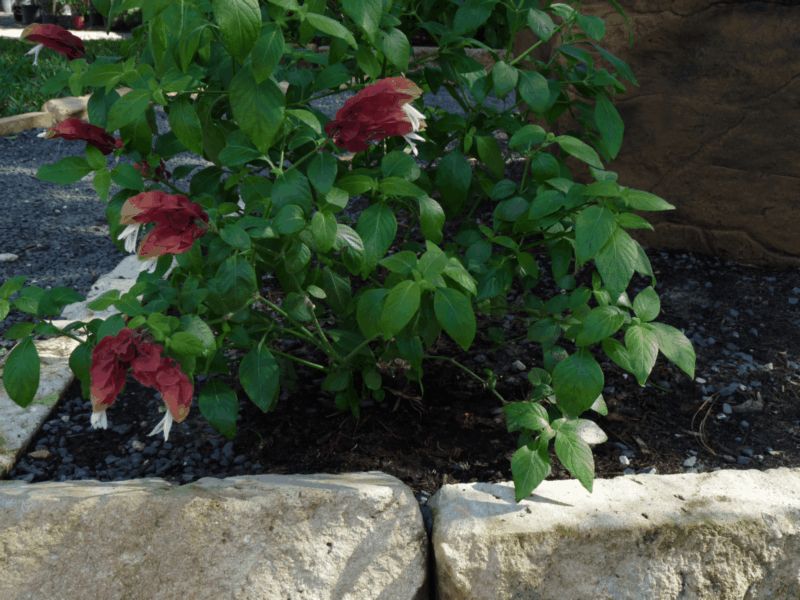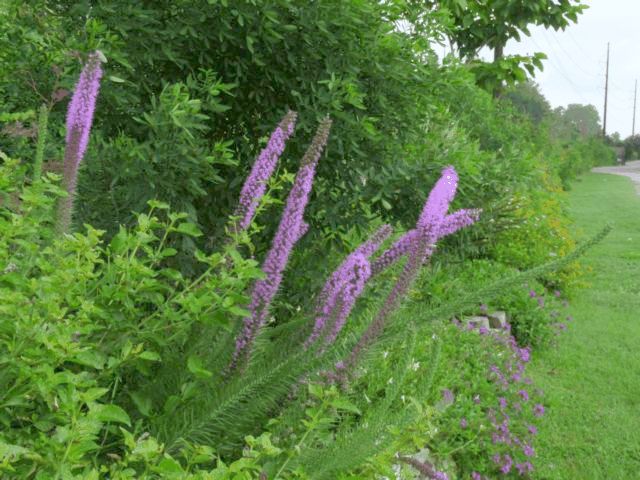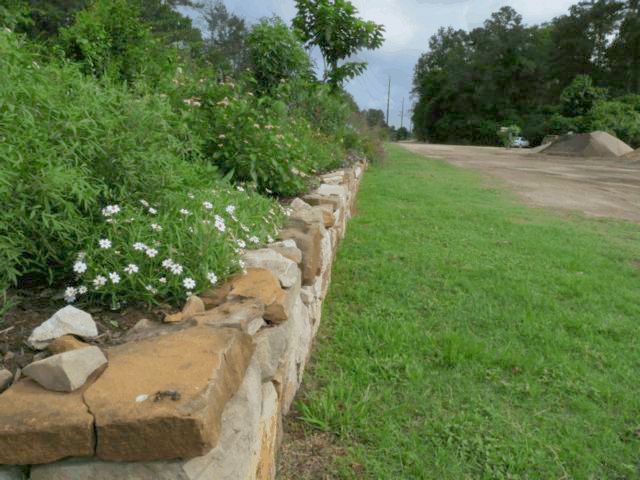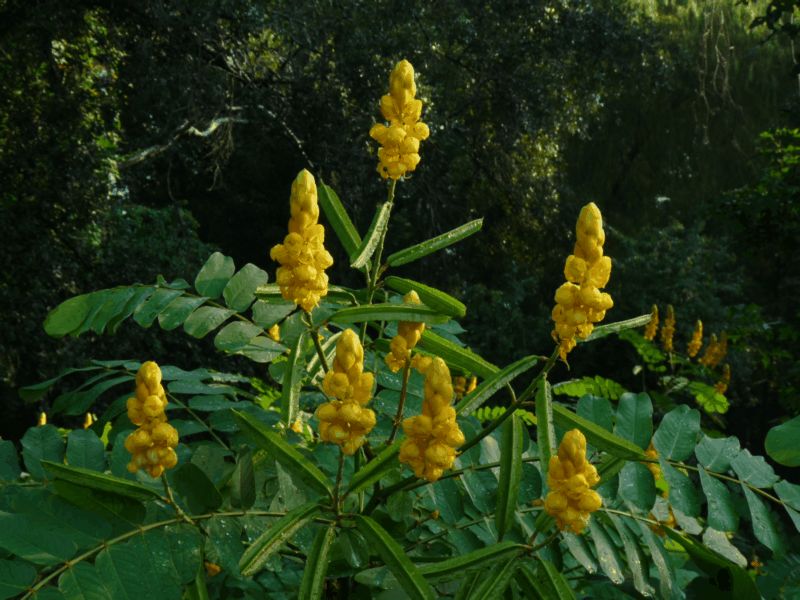




DON'T SHOOT THE MESSENGER
The Truth About Weeds - Friend Or Foe?
If we look at the origin of the word "weed", we find the Anglo-Saxon word, "weod" which means "little herb". Herbs are good plants used for healing and beneficial uses. Weeds are also intended for healing...healing of the soil. "Weeds and Why They Grow"
- Weeds are often called "Pioneer Plants", as their job in nature is to colonize poor bare soil, to provide a quick cover to prevent soil erosion.
- Most weeds are annual species that produce lots of seeds that will live a long time in the soil (dormant) waiting for the right conditions to sprout.
- A study in England found counts of seeds
between 900 to 3,000 per square foot on
cropland!
- Weeds are "opportunistic", able to
sprout and grow quickly, even in bad weather
conditions; hence they often get a jump on crops
or flowers.
- Weeds help improve the soil:
- roots grow deep loosening hard compacted soil
- bring up useful minerals from deep soil layers
- they scavenge and conserve nitrogen that might otherwise wash away
- when roots and tops die, they add valuable organic matter to the soil
- weeds make good cover crops (in 6 weeks can produce 1 ton of dry organic matter)
- weeds prevent erosion
- Some weeds are extremely nutritious (more
nutritious than common vegetables) for both
livestock and humans.
- Weeds serve as food for many forms of
wildlife from butterflies to deer.
- Many weeds provide essential pollen and
nectar that beneficial insects require to
complete their diet.
- Many weeds are useful as herbs or sources of
medicine, dyes or sources of tasty wild
foods.
- The most troublesome weeds are imported from
different countries and have run wild since the
natural predators that kept them in check are not
available.
- Most importantly weeds are teachers. Weeds
tell us about the soil conditions (indicators).
All species of plants have certain environmental
conditions that must be met for them to grow
(soil type, moisture, nutrients, climate, etc.),
weeds are no different.
- Effects of synthetic fertilizer and lime,
tillage, and method of recycling of crop residues
and other organic matter tend to create soil
conditions favorable to weeds! Other synthetic
chemicals (pesticides, herbicides, fungicides,
etc.) make the condition worse, resulting in more
weeds.
- Many weeds only grow on soils with something
wrong with them. These weeds are good indicators
of soil conditions. For example:
Bindweeds - tight crusted soil, low in humus
Foxtail barley - wet soil, possibly high in salts and low in calcium, compacted, possibly acid with unavailable potassium and trace elements
Burdock - acid high iron, low calcium, often with high gypsum and/or dolomitic lime
Chickweed - high organic matter at surface, low mineral content
Chicory - clay or heavy soil
Cocklebur - fairly good soil with high available potassium, and possible low zinc
Crabgrass - tight crusted soil, low calcium, poor decay of organic matter
Dandelion - low calcium, poor decay of organic matter
Dock - wet acid soils, low calcium
Fall panicum - anaerobic (poorly aerated), wet, compacted soil
Foxtail, giant foxtail - tight wet anaerobic soil, possibly high magnesium and/or high nitrogen use
Johnson grass - depleted soil (sick), low organic matter, low calcium, possibly high iron
Lambsquarters - rich, fertile soil, good decay of organic matter, high humus
Common milkweed - good soil, often grows in fence rows and fallow areas
Mustards (wild mustard, yellow rocket, wild radish, peppergrass, etc.) -crusted hardpan, poor soil structure, poor drainage, high crop residues on surface
Pigweed - usually good soil, possibly high in potassium and low in calcium
Quackgrass - wet, anaerobic, poor decay of organic matter, high aluminum (toxic)
Ragweed - dry, poorly aerated soil, low available potassium
Red sorrel - acid soil, low calcium, poor decomposition of organic matter
Smartweed - wet, poorly drained soils
Thistles - fairly good soil, low manganese, possible high iron
Velvetleaf - anaerobic, poor decay of organic matter, low available phosphorus, possible high potassium and magnesium
- Weeds often grow quickly due to excessive
short term poor weather conditions. Some weeds
are better able to grow in cold, hot, wet or
drought conditions. They flourish where the
desired crop or plant fails.
- Bad weather usually has bad effects on the
soil such as crusting or water logging,
conditions which favor weeds (i.e. poor or wrong
soil conditions favor weeds over desired plants
and are the basic cause of weedy fields or
flowerbeds).
- "Don't shoot the messenger".
Chemically intensive methods of gardening views
weeds as a pure pest and tries to wipe out the
weeds with herbicides which makes the problem
worse (soil conditions more favorable to weed
growth). Studies have shown that frequent use of
herbicides increases the number of weeds found.
Also weeds become resistant to the toxic
herbicides.
Remember - weeds are only indicators or symptoms of soil problems....IF the problem is not corrected, weeds will return in greater numbers as nature tries to correct the problem.
- Many "modern" horticultural and
agricultural practices such as high use of
synthetic fertilizers and frequent tilling
actually favor weeds and discourage crops.
- Over 200 weed species are now resistant to
strong toxic herbicides. Using dangerous
synthetic chemicals to control weeds is not
working.
- Weeds such as prostrate spurge and chickweed,
attract tiny predatory wasps that control
caterpillars. Knotweed, wild carrot, and
toothpick ammi also attract several species of
very tiny predatory wasps. These predators help
keep bad insects under control naturally.
- Studies have shown that goldenrod, redroot,
pigweed, ragweed, and mustard attract several
species of beneficial insects upon flowering.
- Studies have shown that some pest prefers to
dine on weeds rather than commercial food crops
IF given a choice. For example the USDA has found
that destructive leafminers prefer ragweed and
redroot pigweed to bell peppers at the research
lab in Weslaco, Texas.
- Studies have shown than the diamondback moth
will lay its eggs on wild mustard (a weed)
instead of cabbage or other brassica plants if
given a choice.
- Many weeds produce special dissolving
substances from their root tips that allow them
to literally "eat" their way through
tough compacted soils allowing for deep root
growth. This feeding from deep subsoil layers
returns minerals to the surface and loosens
compacted soil.
- Many weed species produce deep roots that
recover minerals in sub soil layers. For example
leafy spurge (euphorbia esula) can reach 4-8'
deep and Canadian thistle (Cirsium arvense) can
reach 20 feet deep!
- Prospectors use weeds in the search for
deposits of minerals like selenium or copper.
Early settlers used weeds to indicate ground
water quantity and quality before digging a
well.
- Seldom is one weed species the result of only
one soil or environmental condition. Since there
are many variables involved it is better to use
groups of weeds as indicators of soil problems.
Note: The word "problem" is emphasized
since weeds are not the problem; it is the poor
condition of the soil that is the problem.
- Some weeds that are easily cultivated under
can supply 20-30 pounds of nitrogen per acre.
WEED MANAGEMENT
- In weed management we do not mean
eradication. Even in good soil we will not have
100% control. Weeds seeds can lie dormant in the
soil up to 50 years waiting for the right
conditions to sprout. New weed seeds can blow in
or arrive with purchased plant seed.
- The best time for weed control is when they
are first sprouting; this is when they are most
vulnerable.
- Large plantings of one species tend to
encourage weed germination (monocultures of one
species tend to deplete the soil of certain
minerals creating a soil imbalance). In farming
crop rotation helps reduce weeds.
- Large amounts of synthetic fertilizers create
soil mineral imbalances which in turn help weeds
to germinate and increase the weed problem.
- Application of synthetic chemicals such as
fungicides kills microorganisms in the soil
creating a nutritional imbalance that encourages
weeds to grow. Many fungal species living in
healthy soil eat weed seeds.
- Some plants have the ability to naturally
suppress weed growth, a property that is called
allelopathic. These plants include rye, barley,
oats, wheat, corn, tall fescue, sorghum Sudan
grass, soybeans, alfalfa, red clover, peas, field
beans, sunflowers and buckwheat to name a
few.
- Improve soil conditions. Since the basic
cause of most weed problems is the poor or wrong
soil conditions, obviously correcting what is
wrong with the soil will greatly reduce weed
pressure. Adding organic matter to the soil is
the best and fastest way to improve soil
conditions and compost is the best form of
organic matter to use.
- Maintaining a soil with high fertility and a
balanced soil with plenty of calcium will
eliminate a lot of troublesome weeds. They just
do not want to grow in this type soil. Desired
crops and plants do want to grow in a healthy
balanced soil hence outgrow, out compete and
shade the few weeds that do germinate.
- Encourage a large earthworm population.
- the tunneling activity of earthworms prevents many of the conditions that weed seeds need to germinate
- earthworms often eat weed seeds and either destroy them or reduce their ability to germinate
- earthworms stimulate the growth of microorganisms in the soil and some weed seeds are destroyed by microorganisms
- some microorganisms (bacteria and fungus) live in a symbiotic relationship with plant roots and help plants grow better hence shading out weeds and out competing them for water and nutrients.
- Keep soil pH near the ideal range for most
plants and crops of 6.0 to 6.8 is helpful in
fighting weeds. This range maximizes the
nutrients available to plants and crops helping
them stay healthy and out grow and compete weeds
(if a weed cannot get sunlight due to shading, it
cannot make food, it will not grow well and will
eventually die). This pH range also favors the
growth of earthworms and microorganisms. Many
weeds will grow well outside of this range
whether alkaline or acidic.
- Keep soil covered either by a cover crop or
by mulch. Many species of weed seeds need light
to germinate hence covering prevents light from
reaching the seeds. A cover crop or mulch also
prevents weeds from reaching maturity and
producing more seeds.
- Mechanical control can also be a tool in
controlling weeds if used early in the season
before weeds become established. These controls
include hoeing, raking, burning, disking, mowing,
etc.
- Certain herbivores like to eat weeds and can
be an effective tool under the right conditions.
Geese and chickens have been used for years for
weed control in certain crops. Goats, sheep, and
insects can also be used for certain crops and
plants.
- A recent study has found that a naturally
occurring rhizo-bacteria can reduce populations
of Jointed Goatgrass (Aegilops cylindrica), a $72
million problem per year for farmers, by 64% in
winter wheat. USDA, AW91-5: Soil Bacteria to
Control Jointed Goatgrass in Integrated Cropping
Systems.
- Research is showing that the types and
amounts of pesticides applied to vegetation
(trees, shrubs, plants, etc.) on the edges of a
field effect the type and concentration of weeds
in a field. Pesticide Research Center, University
of Michigan.
- A recent study has found that chisel plowing
or ridge tillage reduces the amount of weed seeds
germinating in corn. The study also found that if
anhydrous fertilizer is replaced with manures
there are lower survival rates of weeds. David A.
Andow, University of Minnesota, LNC88-1:
Integration of Conservation Tillage, Animal
Manures, and Cultural Pest Control in Corn.
- Scientists have found that using Geese are a
way to help control weeds and diversify income
for farmers. USDA, AW91-1: Use of Domestic Geese
to Control Weeds In Agriculture and Forestry
Applications.
- Keeping the calcium and phosphate levels in
equilibrium will roll back more weeds than all
the chemicals in the Dow and Monsanto
armamentarium. "pH and Cation Exchange
Capacity, A Conundrum", Acres, USA,
September 1994.
- One researcher (Dr. Phillip Callahan)
believes that the spines on weed species are
"antenna" that are tuned to receive
(absorb) specific frequencies (energy) from
space. This energy is needed to help restore the
vitality of the soil.
- Broadleaf weeds like a soil environment in
which the available potash exceeds the available
phosphate. Note: Most soil analysis give total
nutrients in the soil, not the chemical form of
the nutrient or it's availability to
plants.
- Grassy weeds tend to like a tight soil. One
way this can occur is if the soil contains an
excess of magnesium to calcium. Calcium tends to
separate soil particles and magnesium makes them
stick together. In some soils the magnesium is
held as trimagnesium ortho phosphate
Mg3(PO4)2-22H2O which allows the soils to dry up
and crack and not release the water to plants in
dry conditions.
- Most microbes in the soil need oxygen to live
(aerobic conditions) and break down plant
residues and complete the decay cycle. Synthetic
chemicals (fertilizers, fungicides, herbicides,
etc.) kill off many microbe species directly and
others by destroying soil structure creating soil
compaction and anaerobic (without oxygen)
conditions. Plant residues at this stage ferment
(instead of aerobic decay) producing toxins like
alcohol, formaldehyde, and methane gas. These
chemicals sterilize the soil even further
creating conditions where weeds like velvetleaf
thrive. Further soil degeneration produces ethane
gas which helps jimsonweed to prosper. Nature is
just trying to correct the problems in the
soil.
- Certain synthetic fertilizers create
conditions that help preserve weed seeds. They
will lay there waiting for the opportunity to
germinate and grow.
- Decaying vegetation can produce chemicals
that prevent the germination of weed seeds
(allelopathy).
- Seeds, whether crop or weed produce chemicals (root exudates or auxins) that help prevent other seeds from germinating. In some soils these auxins last only 1 or 2 days. In biologically active soils these effects can last 6-8 weeks (free weed control).
- Tilling the soil increases weed seed
germination rates. Some weed seeds require only
one-millionth of a second of light to start the
germination process. Tilling the soil exposes
many additional weed seeds to light.
- The two most common soil problems that
encourage weeds are low humus and low available
calcium. Note: Tillage also destroys soil humus
faster.
- Many parasites will attack weeds if given the
chance. These include insects, fungus, bacteria,
etc. For example:
- field bindweed is controlled by a Mediterranean mite that will attack it and nothing else.
- Hemp sesbania is controlled by a fungus found in pasta dough.
- Star thistle is controlled by a Greek weevil.
- earthworms eat and digest many weed seeds.
- Research at Iowa State University has
indicated that corn gluten (available at feed
stores) when applied to lawn and garden areas (10
lbs x 1,000 sq. ft.) serves as a pre-emergent
when applied before spring weed seed germination.
It is more effective than most herbicides and
contains 9-12% nitrogen that helps fertilize the
good plants.
- It is reported that grass burs can be
controlled with humates since grass bur seeds
will not germinate if humic acid is present and
active in the soil. Apply humate at 10-15 lbs per
1000 sq. ft. or 3,000 lbs/ acre. Howard
Garrett's Basic Organic Program Guide
- New research has found that mice (95%) and
ants will eat (70%) of the weed seeds in
agricultural fields depending on the crops grown
hence they are the most effective natural weed
killers. University of Guelph, Ontario,
Canada.
- A Danish study has shown that herbicide
resistant rape in two generations has passed on
its resistance to its weedy brassica cousin.
About 42% of the second generation brassica weed
seedlings had inherited the resistant gene. New
York Times, 7 March 1996.
- New studies have shown that nitrate from
synthetic fertilizers stimulate the germination
of weed seeds. In tests of 85 species of weeds it
was found that nitrate could replace light
requirements for germination, and increase
germination under adverse temperatures. Other
studies have shown that nitrate increases weed
germination rates 11 times higher (3% to 34%).
Another field study found that equivalent
nitrogen supplied from crimson clover (green
manures cover crop) had reduced emergence of some
weeds by 27% while the use of ammonium nitrate
increased rates by 75%. Acres USA February 1997,
Harold Willis, Ph.D.
- Research at the University of Florida has
shown that compost especially immature compost,
applied to crop row middles reduces weed growth
due to its high concentration of acetic,
propionic and butyric acids. Avant Gardener,
April 1998.
- Studies have found that many plants produce
allelochemicals that suppress the growth of other
plants, from the time the seeds germinate till
quite some time after the plant dies. Small
amounts of fresh residues of vegetables, grains,
grasses and weeds have been found to reduce the
growth of many plants (including desirable ones).
This is why unfinished or "green"
compost should not be used very close to young
crops or ornamentals. Avant Gardener, April
1998.
- Tests by the Henry Doubleday Research
Association in England have found that sunflowers
and cucumbers produce root secretions which
suppress many common weeds by 50% or more. Avant
Gardener, April 1998.
- Tests by the Henry Doubleday Research Association in England have found that a Mexican marigold, Tagetes minuta, is remarkably effective against some very tough weeds such as quackgrass, wild oats, field bindweed, ground ivy and plantain. Avant Gardener, April 1998.
Useful References:
WEEDS, Control Without Poisons, Charles Walters
Jr., ACRES U.S.A., 1991
Weeds, Control Beyond Herbicides, Harold Willis,
1993
Weeds and Why They Grow, Jay L. McCaman, 1994
Weeds and What They Tell, Ehrenfried E. Pfeiffer